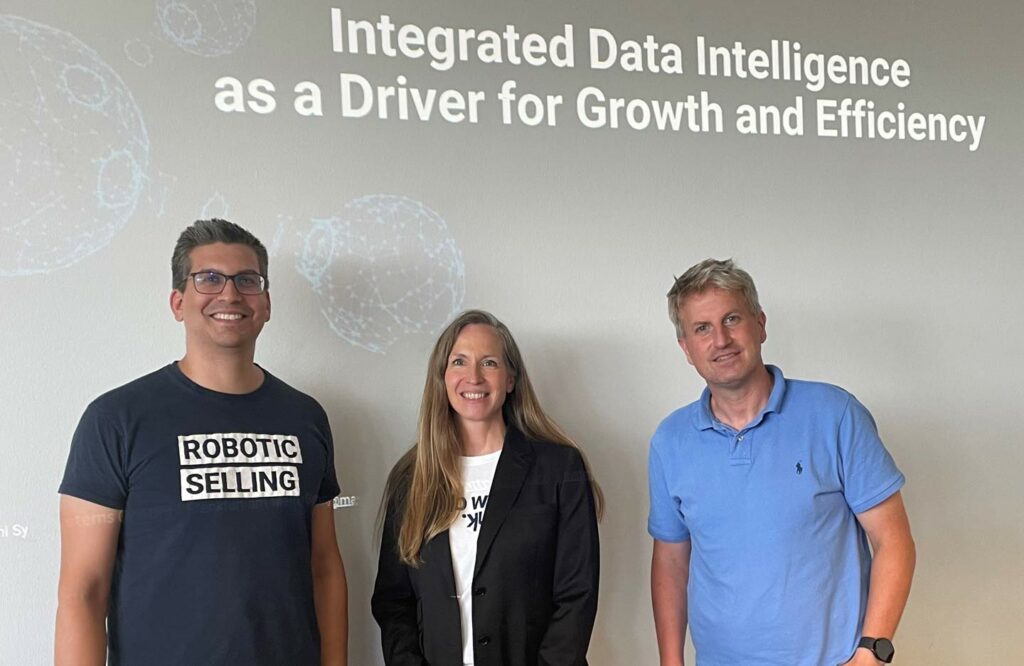It is widely known that marketing and sales must work closely together. Marketing generates the new customer contacts and pre-qualifies them so that Sales can close the deal at the right moment. Sounds simple – and it can be (keyword: marketing and sales automation). However, there is only one prerequisite: both departments must have access to the same database. To information that is up-to-date, complete and consistent. A centralised platform is needed on which all relevant data is pooled. To accomplish this, the Evalanche marketing automation solution must be linked to a CRM system. The result: integrated marketing and sales processes.
Well integrated is half the battle - or even all the battle
Let’s imagine an exemplary customer journey of a potential customer from the B2B midmarket: He reads an interesting article on an online portal with a link to a white paper at the end. He clicks on the link and comes to the landing page of the relevant provider. There, he enters data such as his name and e-mail address and requests the download content. Once they have completed the double opt-in, they download the whitepaper. And then? If the marketing automation solution and CRM system are not connected, there is a break at this point. After all, sales needs to know that marketing has generated a new lead. Of course, marketing could keep an Excel list of new contacts and provide it to sales on a regular basis. But that’s not efficient – especially since once a certain number of leads is reached, it’s simply no longer possible to manage them all manually. The following process would be better: as soon as the lead downloads the whitepaper, a new contact is automatically created in the CRM system. In this way, sales can track the stage of the potential customer’s customer journey right from the start, so that they can contact them at the right moment, i.e., when they are ready for sales.
Linking systems together: integrated marketing and sales processes
In order to connect a marketing automation solution and a CRM system, two approaches have proven themselves in practice: the best-of-breed and the suite approach.
- Best-of-breed strategy: It combines different specialized software solutions via bidirectional interfaces, including those from third-party providers, to form an individual overall system.
- Suite strategy: It seamlessly integrates different tools and subcomponents in a product bundle.
The Evalanche marketing automation platform supports both approaches: Companies can either connect the third-party systems they need to the marketing automation solution via connectors or use an integrated overall system from a single source. The Evalanche platform combines various solutions:
- Evalanche Marketing Automation as core and communication center
- Evalanche Sales as sales cockpit and “Smart Start” CRM system
- Evalanche Data as a central data store
- Evalanche Hub as middleware for real-time data synchronization
Evalanche Analytics in the form of Business Intelligence Dashboards
Consolidate relevant data centrally
Evalanche Hub is “the Marini HubEngine, an integration-as-a-service platform that can be used to connect any systems API-based via plans. As middleware, Evalanche Hub consolidates any data from different source systems and distributes it to the respective target systems, for example, to the marketing automation solution and the CRM system. In contrast to standardized connectors, middleware is particularly flexible when it comes to individual customizations. Companies can configure the connected modules and systems to precisely map their specific needs. The special feature, configuration, takes place in Evalanche Hub according to the no-code principle directly via the user interface. In addition to data, the required functions of existing systems and external microservices can also be integrated into the platform. Since bidirectional synchronization occurs automatically in real time during any interaction, the up-to-dateness and consistency of all data in all connected systems is guaranteed at all times.
Create detailed profiles of people
So much for the theory. In practice, companies usually define the CRM system as the leading one and the associated data pool as the central collection point – simply because the majority of companies have been using such a tool for many years. Through the middleware flows customer-related data, such as.
- Call notes from an acquisition appointment,
- order information,
- contract data (also from old contracts),
- telephone support requests
- and the like
into the respective customer or prospect profile in the CRM system. With supplementary information from the marketing automation solution, including
- clicked newsletter topics,
- requested information materials,
- webinar registrations
- and much more
the profile of each contact continues to evolve.
View customers from all angles
Integrated like this, a marketing and sales platform is created that optimally meets the individual needs of a company. Such marketing and sales automation is in turn the prerequisite for professional customer experience management (CXM). By making information from various sources available in a consolidated form, B2B companies gain a 360-degree view of each individual customer. With each additional piece of information, an increasingly accurate picture of the respective prospect or customer gradually emerges during the customer journey. A company can then optimally support this customer in his or her purchase decision – and beyond – with precisely tailored marketing campaigns. After all, CXM does not end with the signing of the contract. The most positive possible contacts with employees from customer care and service strengthen customer loyalty considerably and make a significant contribution to customers developing into loyal brand ambassadors.
Make data-driven decisions
A marketing automation platform forms the technological basis for holistic lead management and subsequent digital sales. Companies from the B2B midmarket can successively build up profile-specific customer experiences and include every channel, all touchpoints and all affected company divisions in the process. By giving employees from marketing, sales, and customer service alike access to consolidated data in real time, they are able to make data-driven decisions faster – across departmental boundaries. On the Evalanche Analytics Dashboard, they not only see all relevant information, but can also access meaningful reports and data-driven forecasts. Sales also benefit from automated, rule-based processes that help them identify and leverage sales potential in the best possible way. Such a marketing automation platform forms the basis for a customer data platform (CDP) – a platform to which the CMS and e-commerce solutions of medium-sized B2B companies are also connected. This gives them the ultimate 360-degree view of their customers and prospects and allows them to truly inspire them.
About the author
Martin Philipp has over 20 years of experience in online marketing and digital sales of sophisticated products and solutions that require explanation. He is co-managing director of SC-Networks GmbH, manufacturer of the “Made in Germany” marketing automation platform Evalanche and responsible for new customer acquisition and customer enthusiasm.



